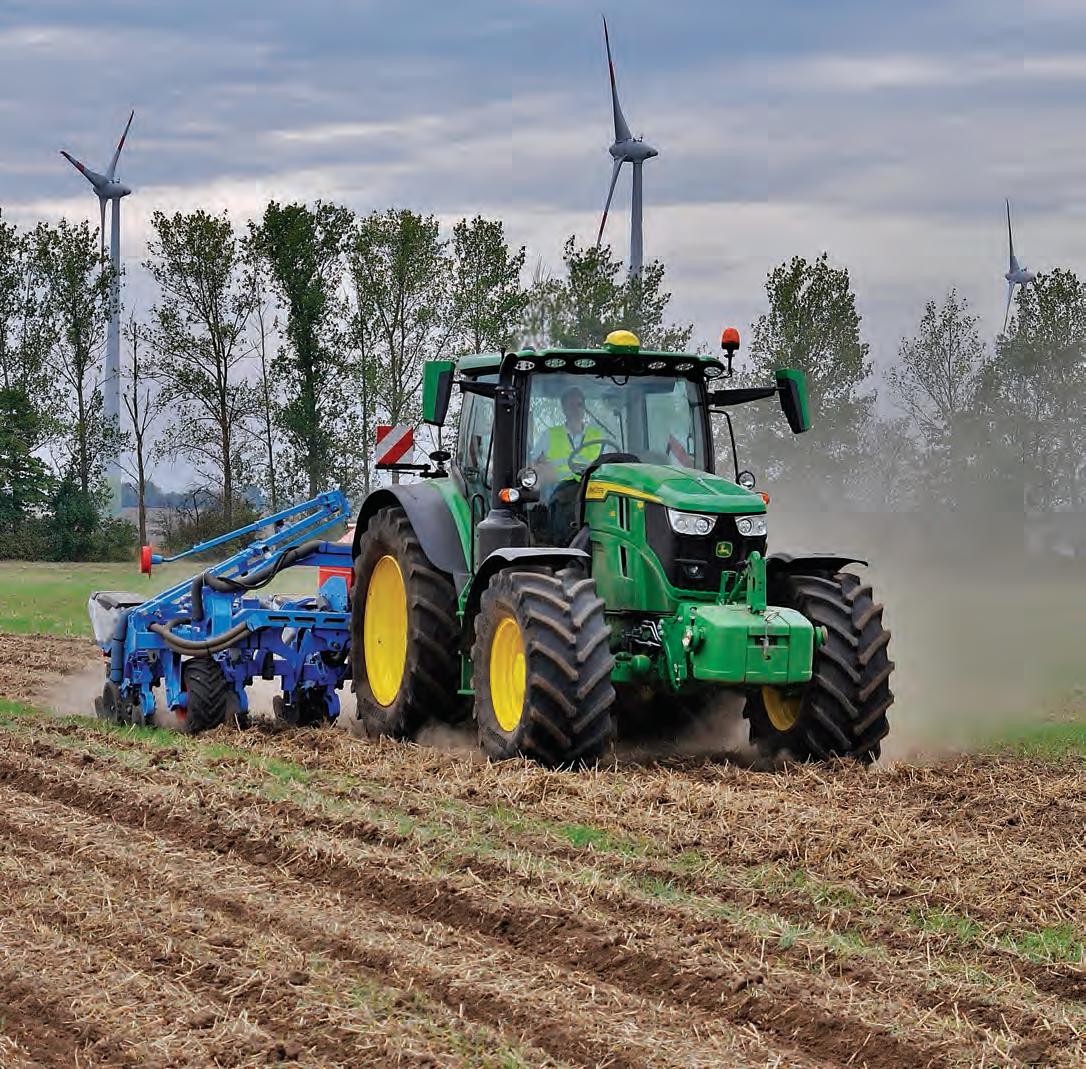
19 minute read
MODERN FARMING
JOHN DEERE SUSTAINABLE FARMING From green to greener
WORDS AND IMAGES
Advertisement
SIMON HENLEY
John Deere’s strategy for sustainable food production and greater global food security utilises a combination of time-honoured farming practices, existing John Deere technology and alternative fuel and power systems
Above and below: John Deere’s Sustainable Farming event in Germany introduced a formula that revolves around the process of connective planning
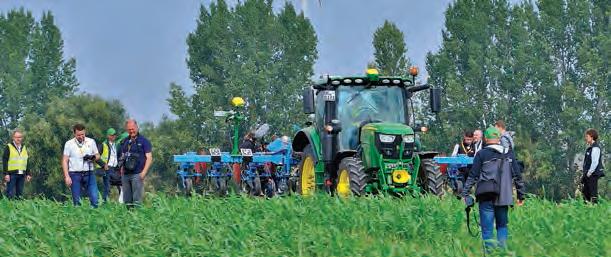

Left: GPS data from a tanker is used to control a precision seed drill. The seed is placed directly above the slurry belt (above inset) and the exact position of every seed planted is recorded

The global population needs food security. We are reminded of this with monotonous regularity. Yet the ability to stabilise food prices while producing food not harmful to the environment is becoming progressively more difficult. We live in a world where agricultural land is being repurposed for anything but food production. Swathes of farmland are being consumed by industrial and residential developments, renewable energy programmes, ecological and environmental protection schemes and big-business incentive programmes such as biodiversity net gain and carbon-offsetting. With less land available for food production than ever and added considerations such as global climate change, it is now imperative that we produce food using techniques that protect the environment. Moreover, this food needs to be produced in a manner that enables farmers to satisfy the ever-stringent environmental and ecological considerations mandated by law. Deere & Company wants to achieve complete sustainability in agriculture. This was announced in Germany at the 2022 Sustainable Farming event, where John Deere explained its ambitions for sustainable food security in the immediate future. The John Deere ideology for sustainable farming revolves around the process of connective planning.
This utilises a combination of existing technology and equipment, with which many UK farmers will already be familiar. Another aspect of particular interest to many John Deere customers is the announcement that the long-awaited eAutoPwr transmission system unveiled in 2019 is now going into full production. The event also launched John
Deere’s MultiFuel technology, which essentially allows the adaptation of existing Deere engines to run on bio-fuels such as rapeseed oil. But before we discuss this, let’s introduce the John Deere strategy for sustainable farming.

HarvestLab
The HarvestLab 3000 NIR (Near Infrared) sensor was introduced in 2007 for self-propelled forage harvesters. It can determine the moisture, protein, sugar, fibre, starch, ADF and NDF content of grass and maize crops for silage. HarvestLab is also fitted to slurry tankers for manure constituent testing in variable rate slurry applications and for performing bench-top nutrient crop analysis. And it’s HarvestLab that is the key element for sustainable farming using the aforementioned The long-awaited process of connective eAutoPwr transmission planning. The formula for system is now going into full production connective planning is divided into three steps. They include harvesting and crop data collection, precision manure placement and seed planting, precision mechanical weed control and spot spraying technology. John Deere started testing HarvestLab on its combines six years ago. It now offers analysis of crop quality and nutrient content in threshed crops following the introduction of the HarvestLab 3000 on the S700 and Bottom: New software for strip tillage manure T-series combines. application requires By determining moisture, starch, protein and oil both the tractor (below content, farmers not only benefit from a marketing inset) and tanker to be equipped with Starfire standpoint, but they can optimise the use of fertiliser, receivers seed, pesticides and fuel for producing a crop the following year. The data collected by HarvestLab on the combine is recorded in the Operations Centre, which is accessed through a PC or tablet. And it’s this information that is the focus point from which connective planning begins. What’s important to understand at this point is John Deere is not telling farmers how to farm, but
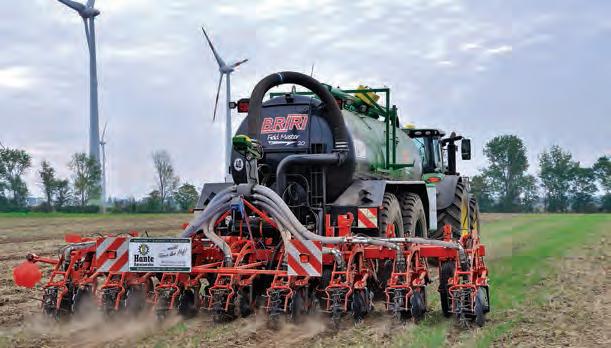
encouraging them to use data they have at their disposal every day to farm more efficiently. This all starts with the production of combinable crops.
Take wheat as an example. The idea is to use a combination of yield monitoring and protein mapping as an indication of where protein is faltering in the field in relation to the crop yield. With oilseed rape the oil content and quality are the discerning factors. Protein content is an indication of nitrogen saturation within a field, while the crop yield is the first step towards monitoring the nitrogen uptake.
The idea is to eradicate the need for expensive chemical fertilisers. By understanding where the yield maximises in a field in relation to the protein content of the crop, the data can be used to optimise the application of readily available liquid manures such as slurry and digestate to ensure nitrogen levels are sustained and the soil is not left depleted.
Once the considerations for nitrogen application have been established using mapping data from the combine, the manure is injected into the soil. The application is controlled by HarvestLab manure-sensing technology. This measures the nutrient value of the slurry, then applies it at the required quantity needed to meet a target application rate according to the nutrient requirements for specific areas of the field.

Above: Mechanical weed control uses data gathered by the AutoPath system on the seed drill to guide a hoe or cultivator
Right: John Deere demonstrated its precision spot spraying technology using a trailed 36m R952i sprayer
Bottom: Using integrated active implement guidance mechanical weeding can be performed at speeds of up to 16kph without crop damage (below inset)
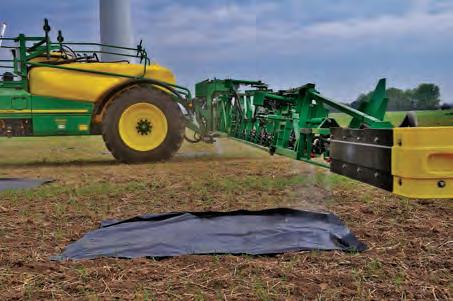
Strip tillage
Effective fertilisation requires not only the redistribution of nitrogen within the field to suit the crop, but also bringing fertiliser directly to the plant roots. Doing this effectively with minimal impact on the soil requires the adoption of strip tillage. John Deere has developed new software for strip tillage manure application, which requires both tractor and tanker to have Starfire receivers. Using RTK guidance to ensure optimum accuracy, once the manure has been applied at a depth of 10-12cm the seed is immediately planted using a precision seeder.
Precise placement is assured using the AutoPath system, which records the position of the slurry belts as it is injected and stores it in the Operations Centre. GPS data from the tanker is then used to control the drill during planting. This is made possible by data connectivity, which John Deere claims is now more accurate than ever thanks to modern data cloud technology. Like the slurry tanker, the seed drill is also equipped with an additional GPS receiver that works in unison with the receiver on the tractor.
At work, even if the seed drill is following an irregular line or is cornering, the seed is always placed exactly above the slurry belt, usually around 7cm above the slurry, and the exact position of every seed planted is recorded.
Although many benefits are associated with optimised slurry fertilisation, the land on many farms can still require additional minerals. When required, nutrient data from the slurry can be used to determine the further need for mineral fertilisers. Additional support can also be provided by analysing the crop.
Using satellite or drone images, the recorded data and application maps can be imported into the Operations Centre and then used when applying the mineral fertiliser. Using drones to map the field can also identify areas of weed infestation and crop disease for the controlled application of pesticides.

The control of weeds
Connective planning requires two strategies for weed control. The first is mechanical weed control, which uses data gathered by the AutoPath system on the seed drill to guide a hoe or cultivator between the emerging rows to remove weeds and volunteers competing with the growing crop. Using two GPS receivers, this can involve steering the tractor, the implement or both. Integrated active implement guidance operates a hydraulic steering ram on a mounted hoe and because it knows exactly where the seeds are, it can steer the implement between the crop rows at up to 16kph.
The second strategy is controlled chemical pesticide application using spot or precision spraying. Utilising precision GPS-controlled systems, including AutoTrac in combination with existing section and single nozzle control, John Deere demonstrated the accuracy of its precision spot spraying technology using a trailed 36m R952i sprayer equipped with a PowrSpray pump.
Chemicals remain a necessity for modern crop production and are required to support mechanical weeding solutions. However, by adopting simple changes such as drone mapping for weeds, utilising precision band
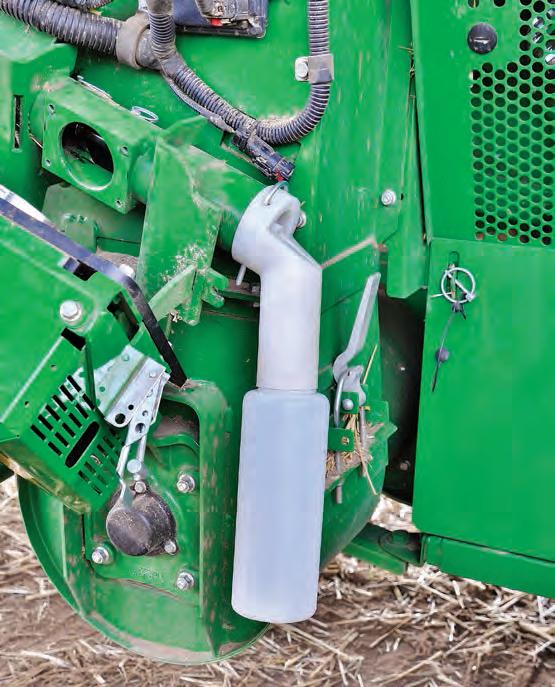
By using the tanker to push the tractor you literally have eight-wheel drive on demand
and/or spot spraying technology, the reduction in chemical use will not only serve to protect the environment but also significantly reduce chemical costs.
The most important aspect of John Deere’s sustainable farming formula is that it utilises equipment and technology that farmers have been using for years. The goal is to have complete connectivity between its agricultural machines by 2026.
Left: The introduction of HarvestLab 3000 on the S700/T-Series combines now offers crop nutrient analysis in threshed crops
Below: Look closely at this 8R 410 and you can just see a pre-production version of John Deere’s long-awaited central tyre inflation system
Below right: The new eAutoPwr 8R 410 was demonstrated pulling a heavily laden Joskin 2800TRS Euroliner tanker up a gradient
Bottom: As the tractor’s tyres started to spin, the off-board electrical system applied power to the electric motors on the tanker axles. Off-board power is supplied at 480v AC or 700v DC via a cable from the tractor (bottom right) MultiFuel
eAutoPwr
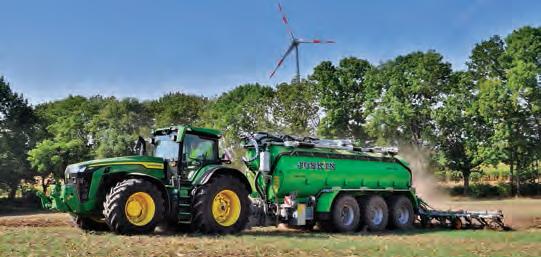
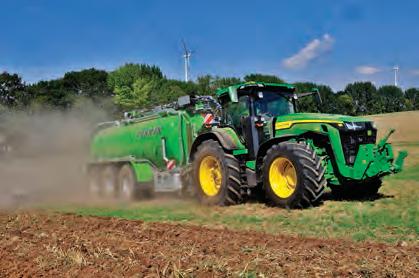
John Deere’s new eAutoPwr electric transmission is arguably one of the most practical and usable innovations for real-world farming we’ve seen to date. According to John Deere, eAutoPwr is the world’s first continuously variable transmission (CVT) with an electro-mechanical power split. This means electric generators within the transmission are used in place of hydrostatics. In other words, the eAutoPwr uses brushless liquid-cooled electric motors to drive four mechanical gear ranges. There are no hydraulic components in the transmission, which means the design is simpler and the transmission provides real-time diagnostics.
John Deere has conducted more than 100,000 hours of testing with eAutoPwr, which as of November 2022 will be available exclusively as an option on the 8R 410 wheeled tractor. Described as being marginally more efficient than the current AutoPwr transmission, the new electric box actually reverses its motors to provide instant forward-reverse shuttling. And that’s not all. As an option, the tractor can be specified with off-board electric power, which enables it to supply 100kW (136hp) of electric power to an implement.
John Deere has been working closely with Belgian manufacturer Joskin, which has developed a tri-axle chassis platform that integrates electric motors on the two rear axles. With a 2800TRS Euroliner tanker filled with water, the eAutoPwr 8R 410 tractor pulled the heavily laden slurry spreader up a gradient. Once the tractor’s tyres started to spin, the off-board electric system was applied, which immediately powered-up the electric motors on the tanker axles. The tractor’s wheels stopped spinning and it surged forward, cresting the gradient without breaking a sweat.
By using the tanker to push the tractor, the weight of the trailed implement is used to increase traction without the need to add ballast to the tractor. That means less weight on the tractor and you literally have eight-wheel drive on demand.
Coolers keep the electric motors cool and the tanker employs an anti-jack-knife system in the drawbar to keep everything in line. Also, because it’s the chassis that contains the motors, the Joskin design is now available to other manufacturers. The uses for this system are colossal.
Even though you will not find MultiFuel as an option on any John Deere price list, the fact that John Deere has taken steps to produce an engine capable of running on bio-fuel is worth a mention. Basically, the tractor hardware is very similar to a standard oil burner. The main differences include the addition of larger diameter fuel pipes, pre-heating systems to keep the plant oil fluid and significantly more powerful fuel pumps.
When Rudolph Diesel invented the compression ignition engine in 1893 his strategy had been to develop an engine that could run on peanut oil. Almost 130 years later we’re now re-exploring the feasibility of his original ideas. These are unquestionably interesting times.
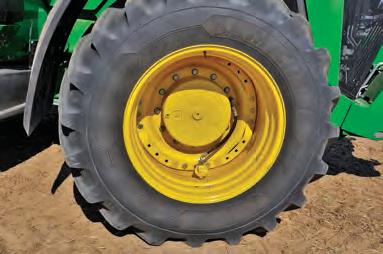
Grove Farm and Pasture House Holiday Cottages is a family-run business whose main enterprise is farming free-range poultry, arable and renewable energy, plus recent diversification into holiday cottages. James Dean and his eldest daughter Sarah are, respectively, fourth and fifth generation farmers on this 300-acre farm, of which 90 acres are rented, located between Brandesburton and Beeford close to the East Yorkshire coast.
Pasture House had been sold by the family in the past but bought back in 2014 as a derelict farmhouse and farmstead, including stables. The holiday cottage project started in 2017 as part of Sarah’s agricultural business course at Harper Adams University. It was subsequently recognised in the Pinnacle Awards at the annual Farmers Club rural business awards in London.


Above: Materials from old Pasture House and the adjacent stables were reused to create luxury holiday lets for up to 16 people on the farm Below right inset: When not behind the wheel of a tractor, Sarah also deals with cottage bookings and routine daily duties for the holiday rental properties
In the early 20th century the farm featured brick and tile buildings to house mixed livestock and heavy horses were used to work the arable land. The old Pasture House was carefully and sympathetically demolished in order to reuse some of the materials to create two luxury holiday cottage lets, which opened in October 2021 for up to 16 guests on the farm.
The farm also hosts two wind turbines (11kW and 50kW output) and a groundsource heat pump system with over 2000m of underground pipes to supply heat and hot water for the farm and nearby holiday cottages. Both these renewable energy sources make the farm self-sufficient and produce a feed-in income.
Harvest time
At the time of our visit James and Sarah were busy bringing in the harvest of wheat and beans with their Claas Lexion 650 combine and mixed fleet of tractors to produce feed for their 26,000 free-range chickens. When not behind the wheel of a John
COTTAGE INDUSTRY
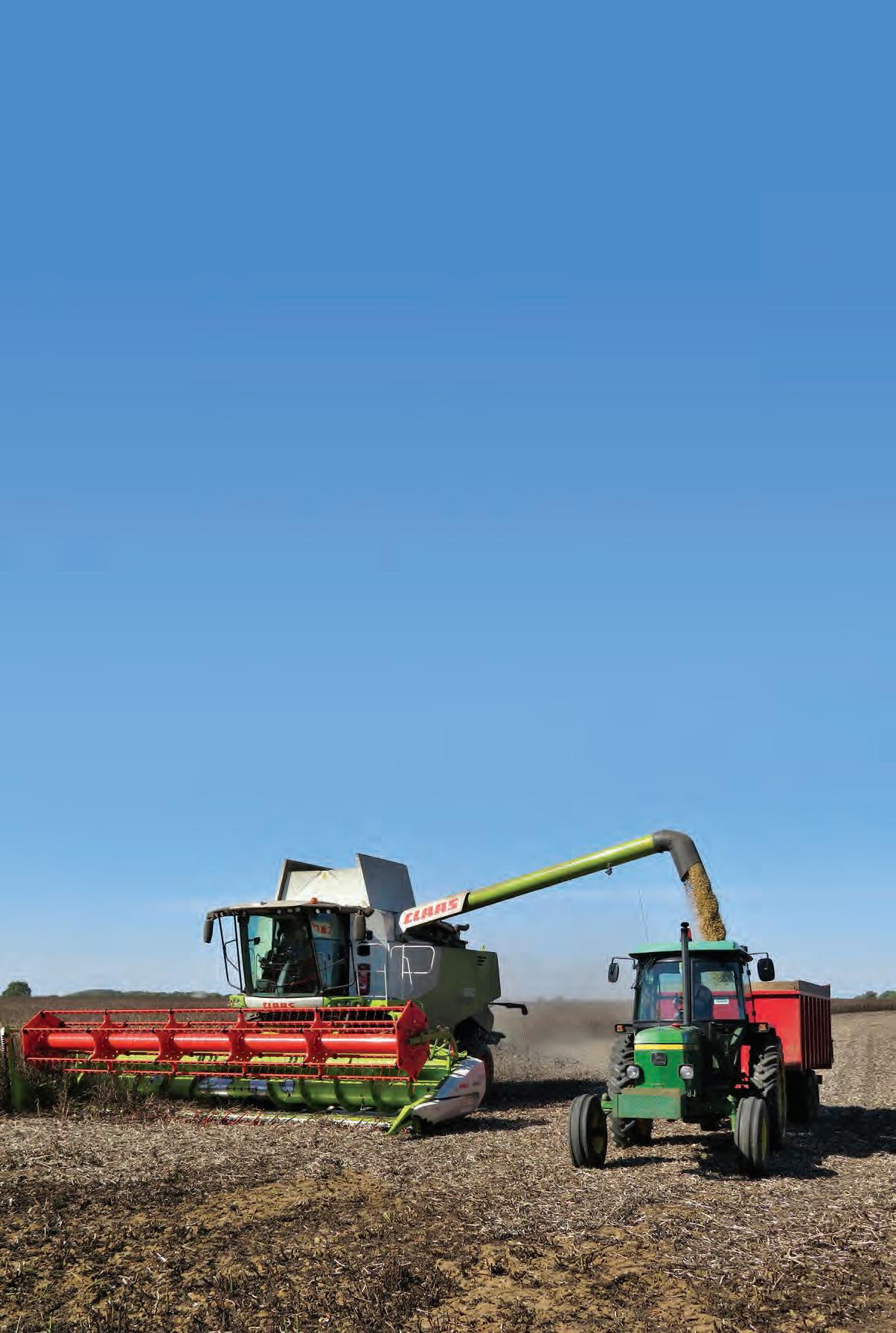
FMJ went to visit Grove Farm and Pasture House Holiday Cottages as the father and daughter team embarked on harvest with their Claas Lexion 650 combine and mixed fleet of tractors to produce feed for their 26,000 free-range chickens
WORDS DAVID WYLIE IMAGES DAVID WYLIE/SARAH DEAN
Farm Facts
Grove Farm and Pasture House Holiday Cottages
Location Near Beverley, East Yorkshire Farm type Arable, chickens, holiday cottages Operators James and Sarah Dean
Core fl eet:
● Claas Lexion 650 combine ● John Deere 6130R ● John Deere 3050 ● John Deere 8320 ● John Deere 2140 ● Claas Axion 820 ● JCB 930 forklift ● Merlo TF40.7

Left: The farm is self-sufficient in chicken feed as they mill all their own home-grown grain
Right: An aerial view of the Deans harvesting this summer. James uses the Claas Laser Pilot system to keep the combine in a straight line

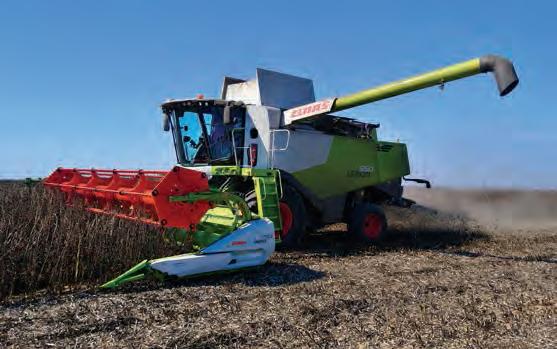
The John Deere 2140 is also called upon to haul the combine’s Vario 770 header between fields Left: Sarah spends most of her time in their newest tractor, a John Deere 6130R, seen here on trailer duties to keep up with the Lexion 650
Far left: Fifthgeneration Sarah Dean works alongside her father James, who is the fourth generation to have worked the farm
Left: The current generation’s great-grandmother Ena was born in the original Pasture House – seen here during its restoration
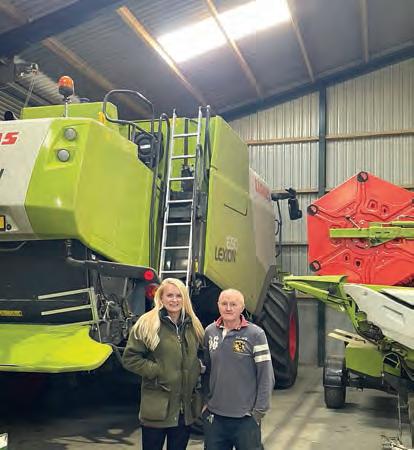
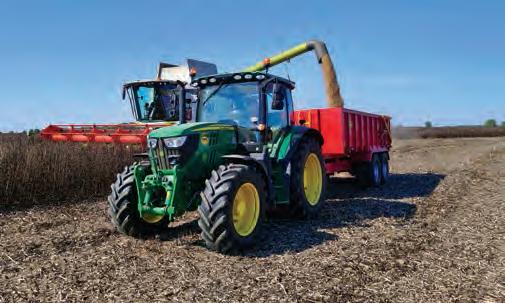
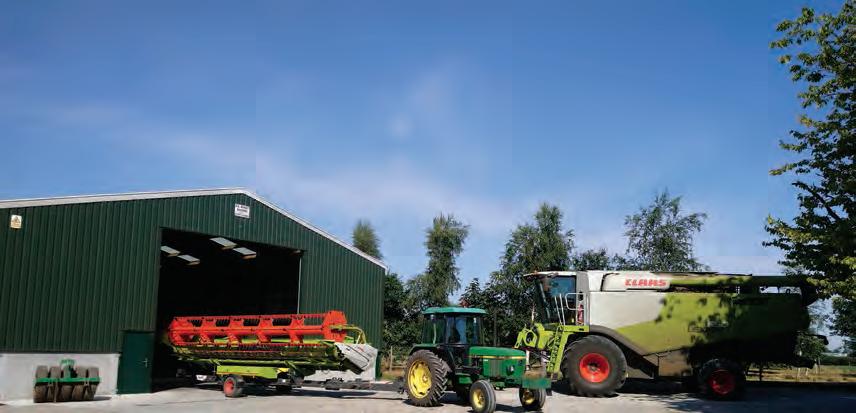
Deere tractor, Sarah was also dealing with cottage bookings and routine daily duties for Pasture House and the adjacent Stable cottage.
August’s exceptionally hot, dry spell of weather meant particular care had to be taken when harvesting their bean crop. Contrary to normal operating practices, James had to start harvesting in the morning while the beans were slightly damp,
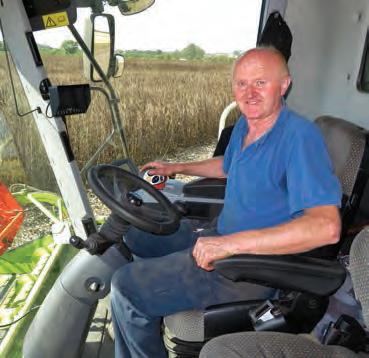
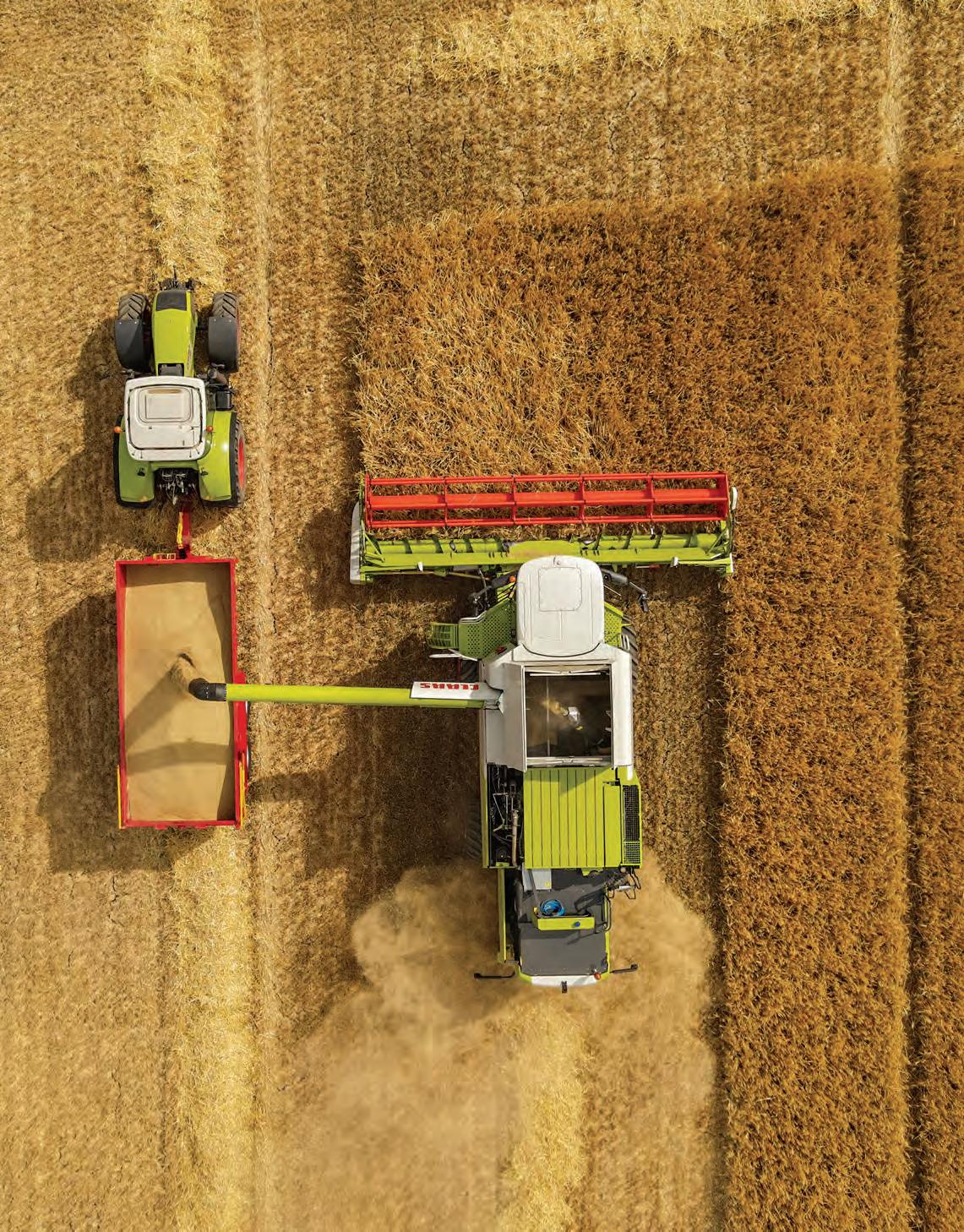
otherwise the head would just shatter on the combine table leading to significant losses of crop.
A six-year crop rotation strategy includes beans, wheat, barley and oilseed rape (OSR), followed by two crops of wheat again and then back to beans. “We generally find we get a good crop of wheat after an oilseed rape crop, perhaps because the OSR crop is sown earlier in the year,” says James.
The farm is self-sufficient in chicken feed as all their grain is milled, including wheat and barley. They have also started using their beans as part of the feed mix instead of imported soya beans for their 26,000 chickens. Their almost 95 per cent productivity rate yield around 24,000 eggs per day. The oilseed rape crop is not used for feed but is sold off the farm.
Above inset: James Dean at the helm of the Claas Lexion 650 combine this summer
Left: The 200hp Claas Axion 820 is considered the best all-rounder and most versatile tractor in their fleet, while the John Deere 8320 is the most powerful
Far left: The 650 has a 7.7m-wide Vario 770 header, which provides an extendable table to cope with different crops Tractor eet
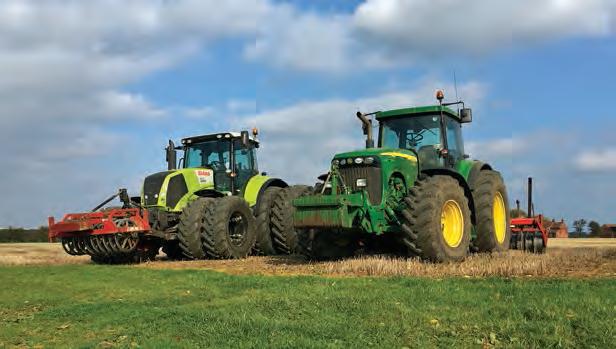
The farm started out with tractors from International Harvester, however back in 1986 a little John Deere 2140 was their first from the brand and it’s still used to haul and tip grain into tight spaces in the storage shed. It’s clocked 8000 hours and has been very reliable. They also use it for moving the combine’s header around the different fields and farms. “Our 2140 is the only tractor without air conditioning, but are the beans is our last crop to harvest it’s a great little tractor for getting into the tight spaces when our grain shed is nearly at full capacity,” Sarah says. However her favourite tractor is the John Deere 8320 due to its size, comfort and performance. That said, Sarah spends much of her time corn carting in their newest tractor, a John Deere 6130R.
The farm also operates a 200hp Claas 820 Axion, which is considered the farm’s best all-round and most versatile tractor and is used extensively for cultivating and drilling.
In the combine
This family-run farm started out with Scottish-built Massey Ferguson combine harvesters before investing in Claas combines. The current Claas Lexion 650 machine is their seventh from the brand, each combine being bigger than the last as James increased the acreage harvested.
Apart from a Claas combine bought new in 2013, the Deans generally favour buying good, well-maintained, pre-owned machines from their local Claas dealer. The current Lexion 650 was a pre-owned machine, three seasons old with 600 hours on the clock. James will generally rack up 150 hours on the combine each season.
“We like to buy Claas combines as we enjoy good sales and product support from our local dealer just two miles away,” explains James. “And we’ve grown very familiar on how to get the best out of a Claas
Below right inset: 26,000 chickens have a high productivity rate that yields around 24,000 eggs per day Right: Like all farmers, the Deans work long hours to harvest their crops, aided by the Lexion’s work lights
combine and how best to maintain it. Our 650 is one of the bigger straw walker models and we find we obtain very good quality straw from it.”
The Lexion 650 has no GPS fitted but does have a laser pilot to provide auto-steering and yield-monitoring technology. It features a 7.7m Vario 770 header, which provides an extendable table to cope with different crops.

Intimate knowledge
James is pleased with the overall performance of his Lexion 650, which will easily do 40t per hour in a good crop of wheat and sips fuel at a rate of around 45 litres per hour. However, with a relatively small acreage he does not use or see the benefit of yield mapping, nor do his contracting customers. They all have an intimate knowledge of how best to manage their soil for each acre.
“Since I drive the combine all the time, and using the yield monitoring, I’ve got a good handle on which parts of the field need more attention than other areas and soil types etc for variable seed rates and spreading fertiliser,” explains James, who does
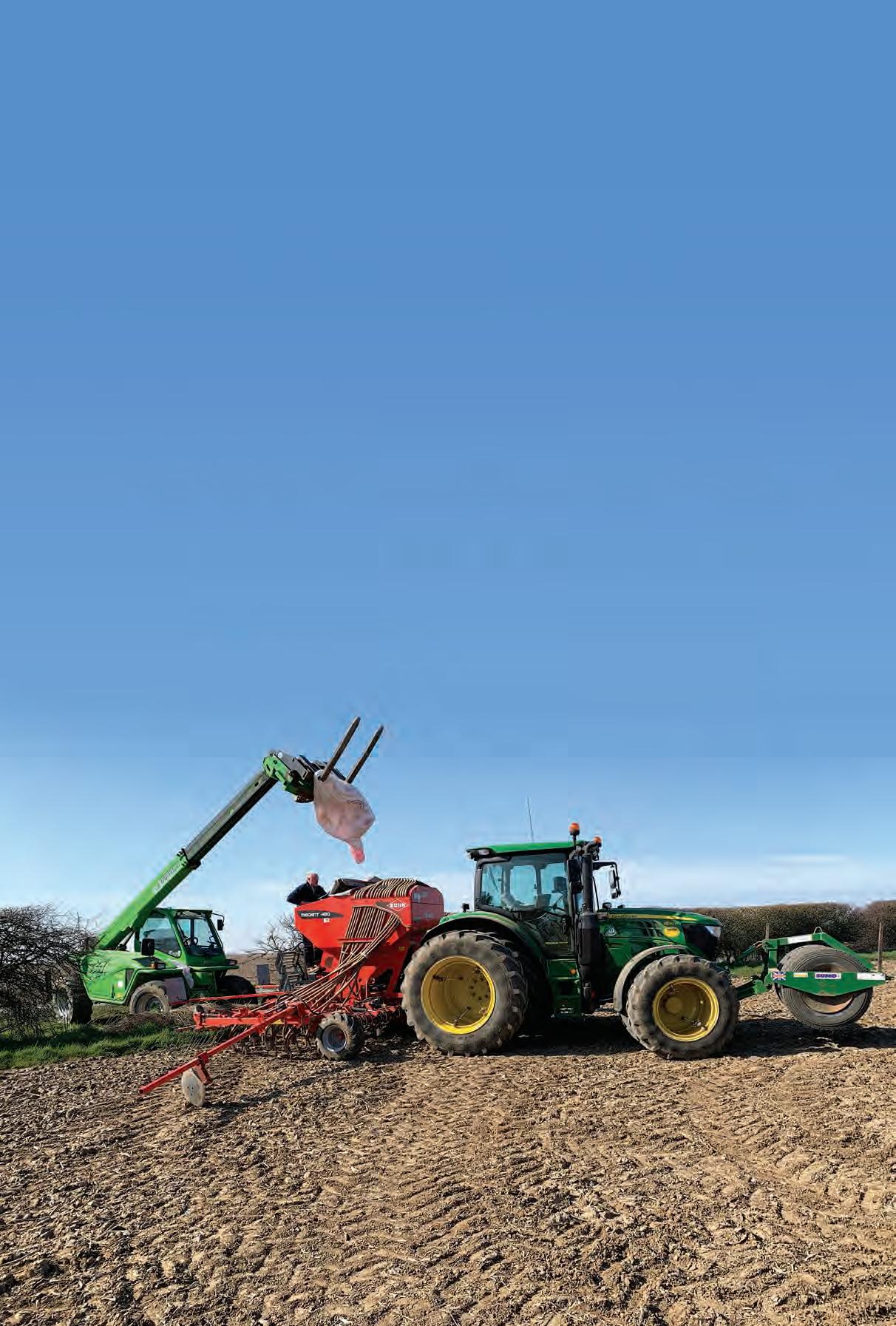
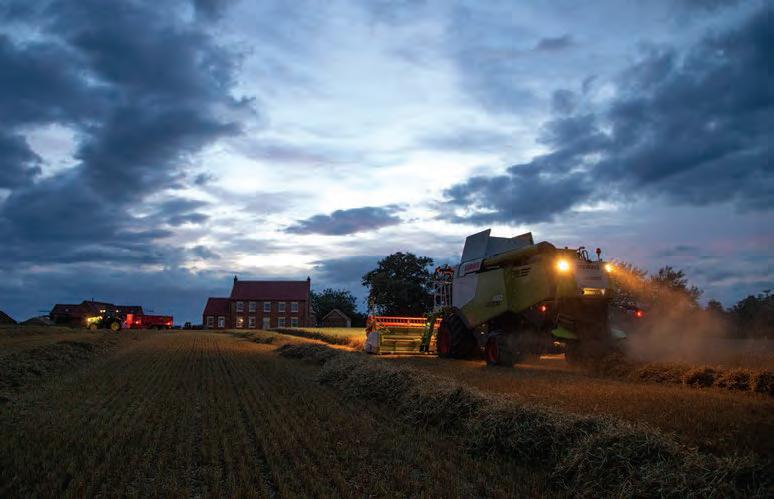
Below inset: Contrary to the norm, James had to start harvesting early in the morning while the beans were slightly damp, otherwise the head would just shatter on the combine table
Below: The farm uses a Merlo TF40.7 telehandler, seen here filling the Kuhn Megant seed drill his own drilling using a 4.8m
Kuhn Megant tine drill.
James and Sarah are clearly satisfied with the performance of the Claas Axion 820 tractor, Claas Lexion 650 combine and their mixed fleet of classic and modern John Deere tractors. Not only have they invested wisely in traditional farming machinery for an arable farm operation, but more interestingly they have made the right strategic decisions to diversify. Their luxurious holiday cottage business, two powerful wind turbines and ground source heat pumps, which in today’s climate of rising energy costs have proved to be extremely beneficial and provide a more stable income stream and a much more sustainable farm for the future.
“While Pasture House and The Stables were a significant investment for the farm, we feel we made the right choice at the right time. Occupancy and income levels are good as a result of people wanting to holiday in the UK. And since we don’t have a large arable farm, the cottages are a good way to spread our financial risk,” Sarah concludes.
ACKNOWLEDGEMENT Thanks to James and Sarah Dean. Full details on the farm’s cottages can be found at www. pasturehouseholidaycottages.co.uk











